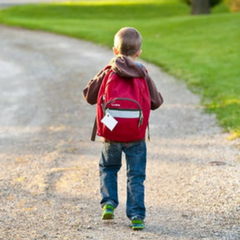
Dressing Your Child With Special Needs For School in Three Simple Steps
September. Famous for being the month of the barley harvest, the beginning of Autumn, and of course; the start of the school term.
For most mums and dads, this can trigger a mix of emotions. For parents with children with special needs, this can be an additionally challenging experience, particularly when their kids are going to school for the first time.
Common anxiety can usually arise from being dressed in unfamiliar clothing or confusion around not being allowed to wear inappropriate clothes. More severe dressing concerns revolve around uncomfortable fabrics with lots of fiddly bits and buttons. These little morning bugbears can get amplified when your little ones feel hurried due to running out of time.
If you regularly find these difficulties in your household, don’t panic; you are not alone.

The key to avoiding September tantrums lies in some straightforward preparation, and three simple steps;
- Choose the right clothing;
- Allow for plenty of time; and
- Create visual a system, and stick to it.
Choose the Right Clothing
Before you start changing your morning routine, it is useful first to consider the clothing that your child is wearing.
Most parents are unaware of the availability of easy dressing clothing, especially when it comes to school uniform. Options that offer elasticated waistbands, popper or velcro fastenings, without pesky zips and buttons can eradicate half the battle before you even get started. You could also consider bodysuits as practical undergarments. The right design can ensure the adaptive clothing item goes undetected by the naked eye while taking your child's sensory needs into consideration. Looking for fabric that is gentle on the skin without scratchy features, such as tags or metal fastenings will help your child feel comfortable throughout the day.
Allow plenty of time
In the beginning, setting a routine will be challenging. By limiting the time you have to get ready together in the morning, the temptation to take-over and dress your child for them will hinder independence and feeling hurried can become frustrating. Allowing plenty of time to make mistakes without fallout, is essential before getting started.
Create a visual system, and stick to it
Now that you have the right adaptive clothing, and have allocated ample time to tackle getting ready, the fun begins. Every child is different, so the initial step is finding the right system that suits their personality. Some parents keep school and home clothing in separate drawers, others start with socks and working up the body, or they create a shape on the floor with the clothes so that their child knows what goes where. Finding what works for your child to set up an individual system is key. Once you have found the right order for them, use coloured cue cards or create laminates that you can hang around the room, visual stimuli indicating what happens next. Encouragement, each step of the way, is vital to developing those steps towards independence.

If you need some help looking for specialist school uniforms for children with special needs, our range will help you. Take a look at our back-to-school clothing to browse polo bodysuits and undergarments that are a perfect addition to any child's wardrobe.

